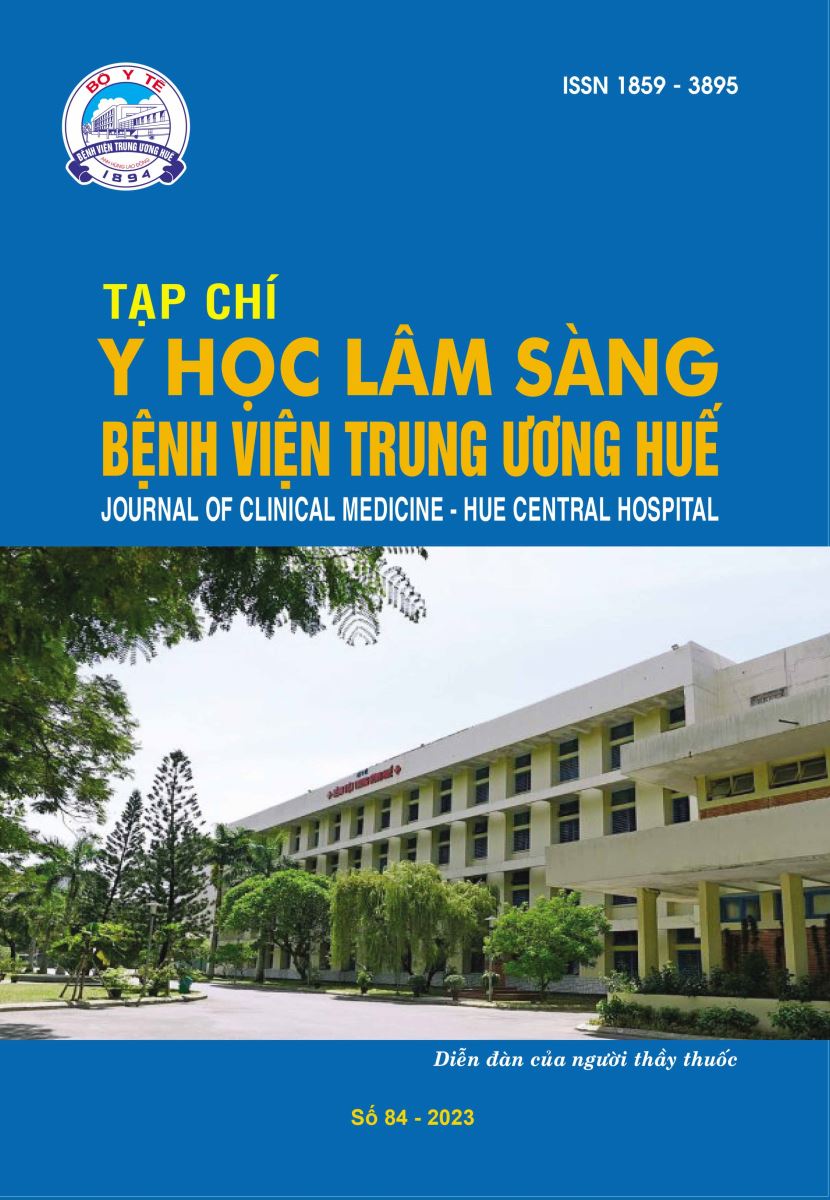Abstract
Background: Neck - shoulder pain is relatively common among medical students and has negative impacts on their physical health and quality of life. This study aims to assess the prevalence and traditional medicine characteristics of neck - shoulder pain among medical students in University of Medicine and Pharmacy, Hue University.
Methods: A Cross - sectional study was conducted on 458 medical students in University of Medicine and Pharmacy, Hue University. The questionnaire involving traditional medicine characteristics of neck - shoulder pain and general condition was designed. Data obtained from the survey were analyzed with descriptive statistics and factor analysis.
Results: The percentage of neck - shoulder pain among medical students was 20,01%. The quality of lifeusing EQ-5D-5L index score was 0,8298 ± 0,1064 and VAS scale was 4,16 ± 1,303. According to traditional medicine characteristics, most of students had pain and stiffness along the Small intestine meridian (44.6%), the Bladder meridian (40.2%). Pain in The San Jiao Meridian of the Hand Shaoyang was associated with side sleeping position (OR = 0.617; 95% CI = 0.479-0.795). Two patterns with a high percentage were wind - cold syndrome (53.3%) and wind - cold - dampnesssyndrome (42.4%).
Conclusions: Neck - shoulder pain is common among undergraduate medical students, most of them have mild and moderate pain, there was no remarkably impact on quality of life. According to traditional medicine, the common patternswere wind - cold and wind - cold - dampnesssyndrome; students mainly had pain in Small intestine meridianand the Bladder meridian.
References
Cohen SP. Epidemiology, Diagnosis, and Treatment of Neck Pain. Mayo Clinic Proceedings. 2015;90:284-299.
Hoy DG, Protani M, De R, Buchbinder R. The epidemiology of neck pain. Best Practice & Research Clinical Rheumatology. 2010;24:783-792.
Borge A, Nordhagen R. Recurrent pain symptoms in children and parents. Acta Paediatrica. 2000;89:1479-1483.
Ståhl M, Mikkelsson M, Kautiainen H, et al. Neck pain in adolescence. A 4-year follow-up of pain-free preadolescents. PAIN. 2004;110:427-431.
Shan Z, Deng G, Li J, et al. Correlational Analysis of neck/shoulder Pain and Low Back Pain with the Use of Digital Products, Physical Activity and Psychological Status among Adolescents in Shanghai. PLOS ONE. 2013;8:e78109.
Woo EHC, White P, Lai CWK. Musculoskeletal impact of the use of various types of electronic devices on university students in Hong Kong: An evaluation by means of self-reported questionnaire. Manual Therapy. 2016;26:47-53.
Buckle P. Ergonomics and musculoskeletal disorders: overview. Occupational Medicine. 2005;55:164-167.
Smith DR, Wei N, Ishitake T, Wang R-S. Musculoskeletal Disorders among Chinese Medical Students. The Kurume Medical Journal. 2005;52:139-146.
Smith DR, Choe M-A, Chae YR, et al. Musculoskeletal symptoms among Korean nursing students. Contemporary Nurse. 2005;19:151-160.
Alshagga MA, Nimer AR, Yan LP, et al. Prevalence and factors associated with neck, shoulder and low back pains among medical students in a Malaysian Medical College. BMC Research Notes. 2013;6:244.
Khoa Y học cổ truyền, Đại học Y Dược - Đại học Huế. Giáo trình Bệnh học nội khoa Y học cổ truyền.
Li Y, Li S, Jiang J, Yuan S. Effects of yoga on patients with chronic nonspecific neck pain: A PRISMA systematic review and meta-analysis. Medicine. 2019;98:e14649.
Skelly AC, Chou R, Dettori JR, et al. AHRQ Comparative Effectiveness Reviews: Noninvasive Nonpharmacological Treatment for Chronic Pain: A Systematic Review Update. Agency for Healthcare Research and Quality (US). 2020.
Hùng ĐC, Hạnh VTB, Bình TT. Thực trạng và các yếu tố liên quan đến đau vai gáy ở những người sử dụng máy tính. Tạp chí Y học thực hành. 2012.
Kuorinka I, Jonsson B, Kilbom A, et al. Standardised Nordic questionnaires for the analysis of musculoskeletal symptoms. Applied Ergonomics. 1987;18:233-237.
Mai VQ, Sun S, Minh HV, et al. An EQ-5D-5L Value Set for Vietnam. Quality of Life Research. 2020;29:1923-1933.
Bộ Y tế. Hướng dẫn chẩn đoán và điều trị bệnh theo y học cổ truyền, và kết hợp y học hiện đại. 2020.
Haroon H, Mehmood S, Imtiaz F, et al. Musculoskeletal pain and its associated risk factors among medical students of a public sector University in Karachi, Pakistan. JPMA. The Journal of the Pakistan Medical Association. 2018;68:682-688.
Zhang D, Wang QF, Wu J, et al. [Study about Traditional Chinese Medicine syndrome of adolescent neck pain]. Zhongguo Gu Shang. 2015;28:628-632.
Yuan Q-L, Guo T-M, Liu L, et al. Traditional Chinese Medicine for Neck Pain and Low Back Pain: A Systematic Review and Meta-Analysis. PLOS ONE. 2015;10:e0117146.
Kim S, Lee S-H, Kim M-R, et al. Is cupping therapy effective in patients with neck pain? A systematic review and meta-analysis. BMJ Open. 2018;8:e021070.
| Published | 20-01-2023 | |
| Fulltext |
|
|
| Language |
|
|
| Issue | No. 84 (2023) | |
| Section | Original article | |
| DOI | 10.38103/jcmhch.84.10 | |
| Keywords | Đau vai gáy, sinh viên y khoa, Y học cổ truyền, hạng kiên thống Medical student, neck - shoulder pain, Traditional medicine |

This work is licensed under a Creative Commons Attribution-NonCommercial-NoDerivatives 4.0 International License.
Copyright (c) 2025 Journal of Clinical Medicine Hue Central Hospital

